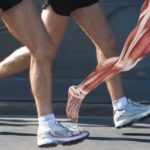UNDERSTANDING MARATHON INJURIES
Unless you fall down and break something, the injuries you are likely to suffer from marathon training are “over-use” injuries related to the repetitive stress of this cyclic weight bearing activity. In long distance training, the joint mechanics are virtually the same for every step, with only minor variations in muscle and tendon function, as the pitch of the road goes up and down.Unless you fall down and break something, the injuries you are likely to suffer from marathon training are “over-use” injuries related to the repetitive stress of this cyclic weight bearing activity. In long distance training, the joint mechanics are virtually the same for every step, with only minor variations in muscle and tendon function, as the pitch of the road goes up and down.
As your joints function in the same limited motion mile after mile, even the slightest misalignment holds great potential for stress to bear down on the “weak links” and susceptible structures in your musculoskeletal system. These susceptible areas are common to us all, and therefore marathon injury patterns emerge and can be predicted.
Pain in the heel area (plantar fasciitis), at the outside of the knee (Illio-tibial band syndrome), or in the posterior thigh (hamstrings) represent just a few of the common vulnerable tissues that breakdown over time. These susceptible tissues sufferer “micro-trauma” with each workout that eventually builds into a “macro-trauma” as the tissue breakdown exceeds your body’s ability to heal.
After a workout, if a proper interval of recovery and rest is provided, your body will repair the “micro-trauma” suffered in your training, and in doing so, make your body stronger than it was before. Problems arise when alignment issues create trauma that is too great for your body to heal between workouts, and the damage starts to build.
Accordingly, when pain symptoms appear and you realize you are injured, the damage to the tissue has been brewing for weeks or longer. Likewise, when the pain subsides with rest, the tissue is still far from healthy. Running injuries have a healing cycle similar to a broken bone. Although the damage will begin to reverse with rest and active rehabilitation strategies, it takes weeks for the injured structure to heal completely.








